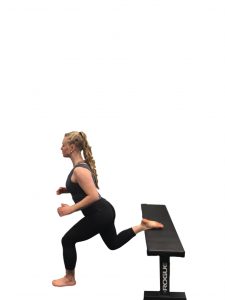WHAT IS UNILATERAL TRAINING?
Unilateral training means training one side or limb of the body independently of the other. Examples of this include single leg squats, single arm pull downs and even doing track drills focusing on one leg at a time.
The exercise below is a great example of a single leg exercise that targets the glutes. Make sure when doing this, you keep your weight in the front foot, driving up through your front heel.
WHY IS UNILATERAL TRAINING SO IMPORTANT FOR RUNNERS?
Our bodies are AMAZING at figuring out ways to accomplish what we ask of it, regardless of whether or not it is the correct way to accomplish that task. Therefore, more often than not, our bodies figure out ways to compensate for a lack of certain muscles or ranges of motion to achieve the desired task. For example, if you want to lift your hand over your head and you don’t have the shoulder flexibility to do so, you might find your shoulder lifting up to your ear while you lean back to get your arm to the desired position. Your hand is now over your head, but at the cost of impinging tendons and/or bursa in your shoulder. As well there can now be excessive strain on your lower back. Although the task is accomplished, you may now have a whole host of other injures on the rise.
“Our bodies are constantly figuring out ways to compensate for a lack of certain muscles or ranges of motion to achieve the desired task.”
Since running is an extremely repetitive activity, any small compensation our body does to allow our hips, knees and ankles to flex and extend in the running stride tends to be magnified with increases in training volume. This can stem from weakness / muscle inhibition on one side of the body which may force the other side of the body to work harder to compensate. On the outside, it may look as though we have a “perfect” running stride, but on the inside, certain muscles and tendons may be working overtime to make up for inactivity of the prime mover.
“It may look as though we have a “perfect” running stride, but on the inside, certain muscles and tendons may be working overtime.”
In an extremely simplistic example, when we perform double legged exercises, (such as squatting, or even running) the weak (or inhibited) side of our body can usually “do enough” to appear as though it is working. At the same time, the stronger side works extra hard to accomplish the task. However, over time, that stronger side may start to get tired from overuse and begin to recruit other muscles and tendons that normally should not be working, to help accomplish the desired task (i.e. your knees try to stabilize your hips instead of your glutes). Again, this will keep up the appearance of a “perfect” running stride in the short term but over the long term will cause serious injury.
However, incorporating UNILATERAL training, can expose weak muscles, help to identify asymmetries in the body and begin to correct those imbalances. This type of training is useful for not only rehabbing injuries that have already occurred from muscle imbalances and asymmetries but also for reducing the risk of future injuries, and can be used for any joint.
“This type of training is useful for not only rehabbing injuries that have already occurred…but also for reducing the risk of future injuries.”
WHAT’S THE BEST WAY TO START INCORPORATING UNILATERAL TRAINING INTO YOUR WORKOUTS?
I often like to start training sessions with the Functional Range Conditioning method of CARS (Controlled Articular Rotations) to warm-up each joint. Then I proceed into unilateral muscle activation exercises (single arm banded pull down, single leg glute bridges, single leg hip thrusters, monster walks). During these, one is hyper aware of how one side of the body feels compared to the other side. This gives some insight to potential problem areas that should be given extra attention either by performing extra activation exercises, or adding in extra sets/ reps to the main set of single leg exercises on that weaker side. This is not to say that one should never perform double legged exercises, but rather strength programs should contain a hybrid of both single and double legged exercises. This way, multiple aspects of strength training are utilized to create a well rounded athlete.
